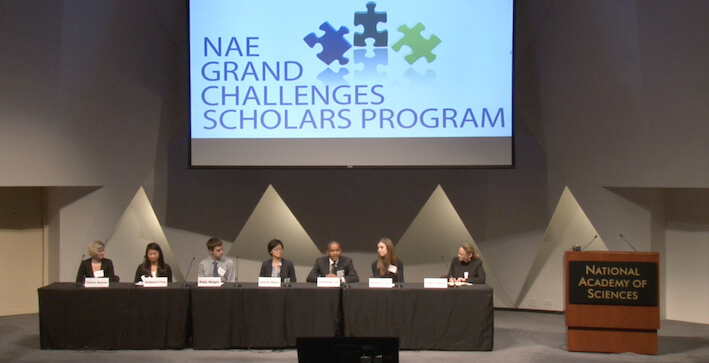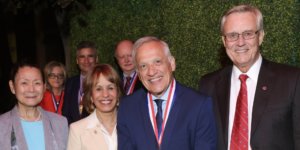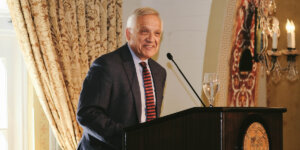
Students and alumni from universities speak at the Grand Challenges Scholars Program Summit in D.C. Photo/USC Viterbi
What if we could preserve donated human organs for up to one day? This is a question Jennifer Erickson of the White House Office of Science and Technology posed to an audience of mostly engineering school deans gathered as part of the first annual summit of the Grand Challenges Scholars Program in Washington DC.
Erickson explained that if engineers could only invent a way to refrigerate and preserve donor organs for up to one day, we could eliminate the waiting list for organ donations in the United States. This innovation could be significant: According to Donate Life America, 8,000 Americans die each year in the US waiting for organ donation.
Erickson was speaking to a cohort that was meeting to discuss how the National Academy of Engineering (NAE) Grand Challenges were being adopted by schools, faculty and students at colleges and even K-12 schools across the country. As much as any global leaders, these deans could have the power to significantly impact and shape the issues future engineers and future problem solvers would choose to address.
The NAE Grand Challenges Scholars Program initiative was founded in 2009 through the combined efforts of Thomas Katsouleas, then dean at Duke University, Richard Miller, President of Franklin W. Olin College of Engineering, and USC Viterbi’s Dean of Engineering Yannis C. Yortsos. Jenna Carpenter, now founding dean of engineering at Campbell University, has led the steering committee that reviews applications of schools that want to establish a GCSP at their institutions. It has since grown to approximately 40 active GCSP engineering schools, with over 100 additional schools committing to institute Grand Challenges Scholars Programs at their institutions. The goal is to produce 20,000 Grand Challenge Scholars in 10 years. The program has received the support of the White House and the NAE and it is now spreading internationally.
At the heart of the GCSP is the development and adoption of a guided self-selected co-curriculum experience based on the National Academy of Engineering “Grand Challenges for Engineering,” including securing cyberspace, preventing nuclear terror, reverse-engineering the brain, engineering better medicines, advancing health informatics, providing access to clean water, making solar energy economical and managing the nitrogen cycle. The Grand Challenges Scholars Program is the extension of these challenges to college campuses. The GCSP aims to specially equip students to solve these challenges through interdisciplinary and multi-cultural experiences.”. The GCSP also includes research and business/entrepreneurship components and encourage participating students to engage in activities that demonstrate social consciousness.
Students and alumni at the Summit from USC, Arizona State, Louisiana Tech, Duke, Iowa University, Olin, and others spoke of how the GCSP shaped their college careers and beyond—how it unified their interests and pointed them in a direction—enriching their perspectives and what they could contribute as engineers—in areas like sustainability, repairing urban infrastructure, generating solar power, and biomedical engineering. As Duke University’s Lauren Shum pointed out, GCSP provided context for their careers and engineering’s place in the world.
Viterbi alumna Stephanie Fong, a biomedical engineering B.S. and a mechanical engineering masters graduate, now part of a technology management rotation program at Edwards Lifesciences, told the audience in Washington D.C. how GCSP “encapsulated her college experience” including research, study abroad, volunteer efforts, and her interdisciplinary minor in the School of Cinematic Arts. Fong recalled how Viterbi’s iPodia program, which created a virtual classroom shared with students in Israel focused on “quantifying the ‘X’ factor that leads to a breakthrough,” helped her create better designs and understand how to scale innovations. She then discussed her efforts to “tackle problems that spanned continents.” This was realized in her co-creation of FlexSpecs, a low cost alternative to traditional glasses with adjustable prescriptions that she entered in the Min Family Challenge in Social Entrepreneurship, and won. (She and her co-founders are currently working on securing a patent with their $15,000 prize)
While this campus-focused movement started as a grassroots level among a few engineering schools deans, it is now snowballing—being adopted by engineering deans in the US, borrowed by different disciplines including USC’s Suzanne Dworak-Peck School of Social Work and the American Academy of Social Workers. The final panel in Washington D.C. addressed how the Grand Challenges might impact the future of all higher education—because as Thomas Katsouleas, now Provost at the University of Virginia, noted, the NAE’s Grand Challenges can’t be solved without other disciplines. Rick Miller of Olin College of Engineering believes that the Grand Challenges offer a unifying and motivating cause for students. In his talk, Miller offered that the competencies outlined in the NAE Grand Challenges Scholars Program line up with mindsets that are correlated with success. Ernie Wilson, Dean of the USC Annenberg School of Communications, suggests that GCSP competencies could extend even more broadly to embracing and learning soft skills demanded by employers via an approach he finds in Third Space Thinking.
The next formal event for the Grand Challenge Scholars Program will be the student day at the Global Grand Challenges Summit in July 2017. In addition, educators in China have opted to learn about this approach to engineering education. Dean Yortsos of USC views the GCSP as the “blueprint for engineering education in brick-and-mortar universities” and further believes that it can also be the blueprint for any university discipline.
Click here to watch the morning panels.
Published on November 20th, 2016
Last updated on March 10th, 2017









